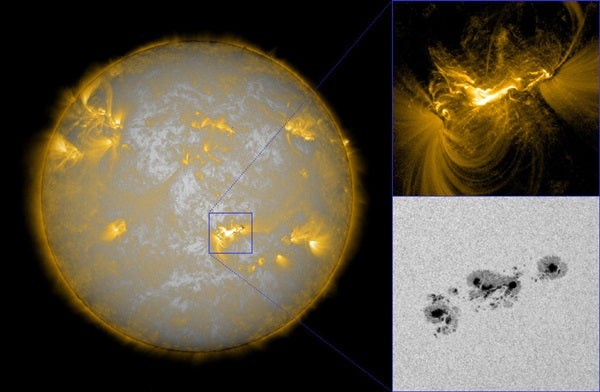“Sunspots are features where magnetic field generated in the Sun’s interior pushes through the surface and into the atmosphere,” said Daniel Brown from the University of Central Lancashire, United Kingdom. “Twisting the Sun’s magnetic field is like twisting an elastic band. At first you store energy in the elastic, but if you twist too much the elastic band snaps, releasing the stored energy. Similarly, rotating sunspots store energy in the Sun’s atmospheric magnetic field. If they twist too much, the magnetic field breaks, releasing energy in a flash of light and heat that makes up the solar flare.”
The flare occurred at 1:44 a.m. February 15, 2011, when the Sun released the largest recorded solar flare since December 2006, and the first flare of the current solar cycle to be classified as the most powerful “X-class.” Looking at 5 days of SDO observations that included this flare, Brown found that the active region that flared contained five newly emerged sunspots. All five of the sunspots rotated between 50 and 130 degrees, some in a clockwise and some in an anticlockwise direction, over the 5 days of observations.
“Rotating sunspots are an extremely efficient way to inject energy into the magnetic field of the Sun’s atmosphere,” said Brown.
“With five sunspots rotating at the same time, enough energy has been injected into the atmospheric magnetic field to produce the largest solar flare seen for almost 5 years.”
In addition to the large X-class flare, the same region also released over 40 smaller flares during the 5 days studied.
“Sunspots are features where magnetic field generated in the Sun’s interior pushes through the surface and into the atmosphere,” said Daniel Brown from the University of Central Lancashire, United Kingdom. “Twisting the Sun’s magnetic field is like twisting an elastic band. At first you store energy in the elastic, but if you twist too much the elastic band snaps, releasing the stored energy. Similarly, rotating sunspots store energy in the Sun’s atmospheric magnetic field. If they twist too much, the magnetic field breaks, releasing energy in a flash of light and heat that makes up the solar flare.”
The flare occurred at 1:44 a.m. February 15, 2011, when the Sun released the largest recorded solar flare since December 2006, and the first flare of the current solar cycle to be classified as the most powerful “X-class.” Looking at 5 days of SDO observations that included this flare, Brown found that the active region that flared contained five newly emerged sunspots. All five of the sunspots rotated between 50 and 130 degrees, some in a clockwise and some in an anticlockwise direction, over the 5 days of observations.
“Rotating sunspots are an extremely efficient way to inject energy into the magnetic field of the Sun’s atmosphere,” said Brown.
“With five sunspots rotating at the same time, enough energy has been injected into the atmospheric magnetic field to produce the largest solar flare seen for almost 5 years.”
In addition to the large X-class flare, the same region also released over 40 smaller flares during the 5 days studied.










